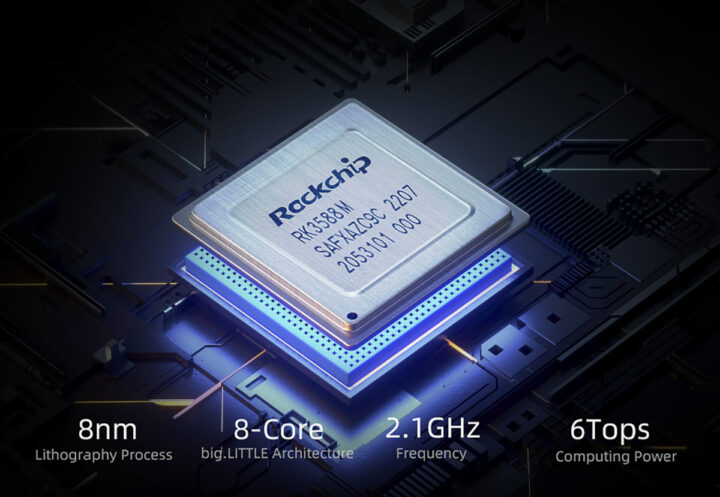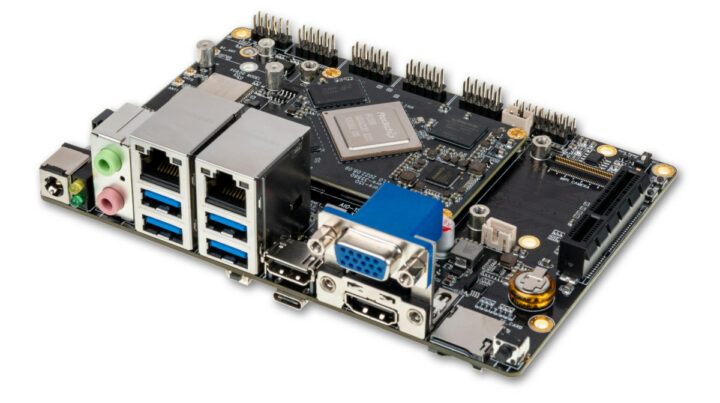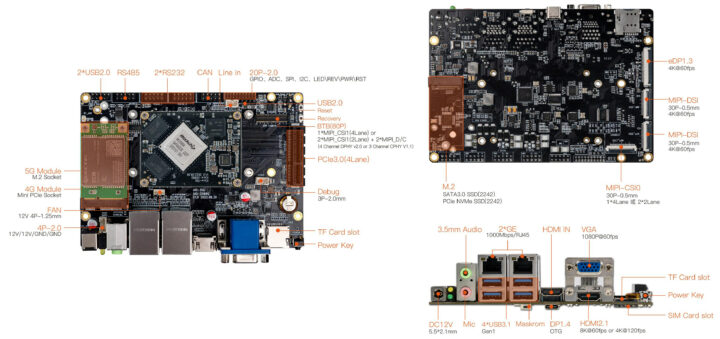Rockchip RK3588M is an automotive-grade variant of the Rockchip RK3588 octa-core Cortex-A76/A55 SoC that supports at least 6 Full HD displays and 16 camera inputs and can simultaneously run the car dashboard, in-vehicle infotainment, a digital rearview mirror, headrest monitors, ADAS system, and more.
The frequency of the Cortex-A76 cores is limited to 2.1 GHz, and the Cortex-A55 cores to 1.7 GHz, against 2.4 and 1.8 GHz for RK3588, probably to operate in a larger temperature range required by the automotive market. I could not find any RK3588M datasheet yet, but we can find more details through the Firefly AIO-3588MQ automotive mainboard built around the RK3588M processor.
Firefly AIO-3588MQ specifications:
- SoC – Rockchip RK3588M octa-core processor with
- CPU 4x Cortex-A76 cores @ up to 2.1 GHz, 4x Cortex-A55 cores @ up to 1.7 GHz
- Arm Mali-G610 MP4 GPU with OpenGL ES 3.2, OpenCL 2.2, Vulkan 1.1 support
- 6 TOPS AI accelerator
- Video decoding:
- 8Kp60 H.265/VP9/AVS2
- 8Kp30 H.264 AVC/MVC
- 4Kp60 AV1
- 1080p60 MPEG-2/-1/VC-1/VP8
- Video encoding – 8Kp30 H.265 / H.264
- Up to 32-channel 1080p30 decoding and 16-channel 1080p30 encoding can be achieved.
- System Memory – 4GB, 8GB, or 16GB (Up to 32GB optional) 64-bit LPDDR4/LPDDR4x/LPDDR5
- Storage – M.2 SATA3.0 SSD (2242), microSD card slot
- Video Output
- HDMI 2.1 up to 8Kp60 or 4Kp120
- DisplayPort 1.4 up to 8Kp30fps (via USB-C)
- VGA up to 1080p60
- eDP1.3 connector up to 4Kp60Hz
- 2x MIPI DSI display interfaces up to 4Kp60
- Up to 6 independent displays
- Video Input
- Dual 16M ISP on RK3588M
- HDMI input up to 4Kp60 with support for HDCP 2.3
- 30-pin MIPI-CSI(0) connector configurable as 1x 4-lane or 2x 2-lane
- Board-to-board connector with 4-lane MIPI_CSI(1) or 2x 2-lane MIPI-CSI(1) + 2x MIPI_D/C (4-lane DPHY v2.0 or 3-lane CPHY V1.1)
- Audio
- 3.5mm audio jack
- Digital audio output via HDMI 2.1 and DP 1.4 ports
- Line-in via header
- Microphone input
- Networking
- 2x Gigabit Ethernet RJ45 ports
- 2.4GHz/5GHz dual-band WiFi 6 (802.11a/b/g/n/ac/ax), Bluetooth 5.0
- Optional 4G LTE/5G cellular
- USB – 4x USB 3.1 Gen1, 1x USB Type-C (OTG/DP1.4) port, and 3x USB 2.0 (via pin header)
- Serial – 2x RS232, RS485, CAN Bus
- Expansion
- 4-lane PCIe 3.0 slot
- mPCIe and M.2 sockets for wireless modules
- 20-pin 2mm-pitch header with GPIO, ADC, SPI, I2C, LED, REV, PWR, RST
- Power Supply – 12V DC / 2A recommended via 5.5/2.1mm DC jack or 4-pin header
- Power Consumption
- Idle – About 0.72W (12V/60mA)
- Typical – About 2.4W(12V/200mA)
- Max – About 14.4W(12V/1200mA)
- Dimensions – 146 x 102 x 37.5mm
- Weight – Around 200 grams
- Temperature Range – Operating: -40°C to 85°C in product page but -20°C to 60°C in the board’s datasheet
- Humidity – 10%80 % (storage)
The company offers support for Android 12.0, Ubuntu Desktop and Server, Debian 11, and buildroot RTLinux for the board//system-on-module. Firefly also mentions Kernel-based Virtual Machine
(KVM) and Docker container support, as it will be necessary to support critical (e.g. dashboard) and non-critical (e.g. infotainment) parts of the software with isolated and likely different operating systems. Technical documentation can be found in the Wiki to get started with Android, Linux, and RTLinux.
The first time I found out about the RK3588M was in a demo last February at the RKDC (Rockchip Developer Conference) showing a system driving four independent displays and two gamepads.
#RK3588M as car play/entertainment system. Single chip drives 4 individual screens and 2 gamepads. pic.twitter.com/dz70oxMaQb
— BG5USN (@BG5USN) February 24, 2023
Firefly is selling samples of the AIO-3588MQ automotive-grade AI mainboard on its store for $539 with 8GB RAM and 32GB flash, and $759 in 16GB/128GB configuration. Additional information may also be found on the product page.

Jean-Luc started CNX Software in 2010 as a part-time endeavor, before quitting his job as a software engineering manager, and starting to write daily news, and reviews full time later in 2011.
Support CNX Software! Donate via cryptocurrencies, become a Patron on Patreon, or purchase goods on Amazon or Aliexpress







